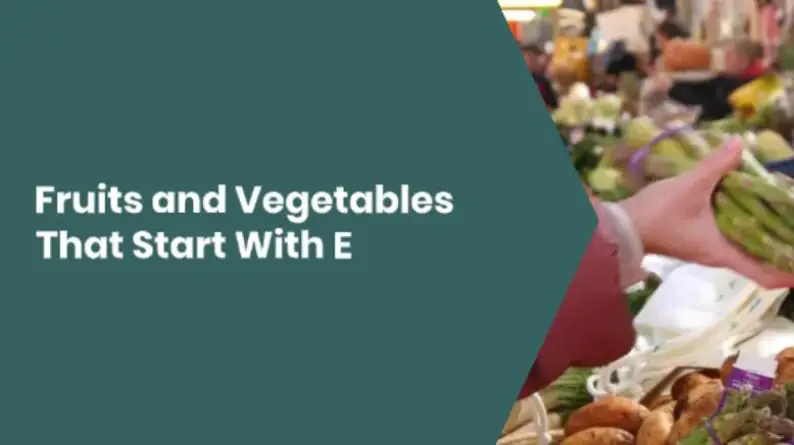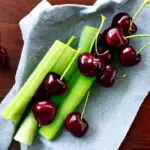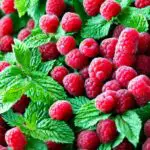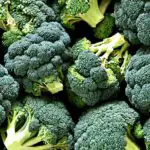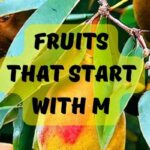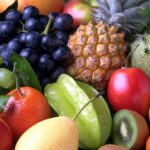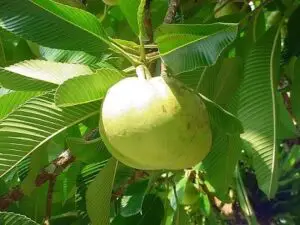
There are 14 fruits and vegetables that start with E, and we will look at all of them below. All of these fruits and vegetables are plant-based and super good for you!
For just the list of fruits that start with E, see Fruits that Start With E. For the list of vegetables by themselves, see Vegetables that Start with E.
If you would like a complete list of healthy foods that start with E, visit Healthy Foods that Start with E.
For this page, we’ll look at the complete list of fruits and vegetables that start with E below!
- Fruits that Start with E
- Eggplant
- Elephant Garlic
- Elephant Apple
- Escarole
- Elderberry
- Elephant Foot Yam
- Entawak
- Enset (Ensete) or Ethiopian Banana
- Emu Berry
- Emu Apple
- Evergreen Huckleberry
- Earthnut Pea
- Egg Fruit
Fruits that Start with E
The following is a list of 14 fruits that start with E. Each fruit also has an in-depth description and more information associated with it.
Endive
The first on the list of vegetables that start with E is the vegetable Endive.
Endive is a leafy green vegetable with a slightly bitter taste. It originated in Belgium and you see it a lot in salads. Interestingly enough, it’s grown under the soil in dark rooms like mushrooms, in order to preserve its flavor.
Benefits of Endive
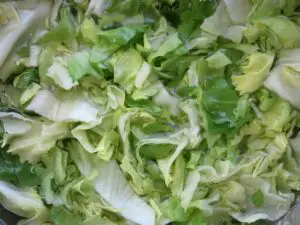
- Rich in fiber and supports digestion
- High in several antioxidants including quercetin, myricetin and kaempferol. (All of which I don’t know how to pronounce)
- Rich in Vitamin K. Half a cup gives 72% of your vitamin K needs.
- It may help with bone strength. Vitamin K helps with bone strength.
- Animal studies show endive may protect liver function.
- Great for weight loss since it’s high in fiber and low in calories.
- Prevent cancer. The powerful flavonoid kaempferol has been shown to inhibit cancers. It creates cell death in tumors.
- High in potassium and folate, both of which help with heart health.
- Supports good vision by being high in Vitamin A.
- Supports healthy pregnancy with high folate levels.
How to Eat Endive
The most popular way is to slice it up and add it to salads. They can also be used to hold appetizers, or they can be used with dips. It can also be baked, braised, sautéed, or stir-fried.
Endive Recipe
Here’s an endive recipe for Lemony Seared Endives.
Eggplant
The first of the foods that start with E, is probably a surprise to most. That’s because most people might think that an Eggplant is actually a vegetable. But as mentioned in Vegetables that Start with E, eggplants are actually fruits and not vegetables!
Eggplants are known as aubergines, and belong to the nightshade plant family. Eggplants can be red, green, or black, but the most common you have probably seen is deep purple.
Eggplant Benefits
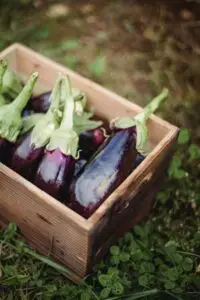
- Eggplants are high in vitamins, minerals and fiber.
- They are also high in antioxidants, which are very good for us and can even help fight chronic diseases.
- The purple color of eggplants comes from the anthocyanins, a pigment that’s an antioxidant.
- Eggplants have been found to possibly improve the heart by lowering LDL cholesterol and triglycerides in animals.
- Eggplants might help with weight loss since they are low in calories and high in fiber, which helps us to feel fuller.
- Eggplants have a compound called SRG that is found in nightshade plants, which might help to fight cancer.
How to Eat Eggplant
- Eggplant can be cut into round pieces or strips and baked.
- They can be added to curries.
- It can be cooked and then mashed into a dip. Baba Ghanoush uses mashed eggplant.
- They can be roasted in the oven with olive oil on top.
- Eggplant can be used in place of noodles in lasagna.
- It can be stir-fried.
- Eggplant can be placed on pizza.
Eggplant Recipes
- Baba Ghanoush
- Eggplant Parmesan
- Ratatouille
Elephant Garlic
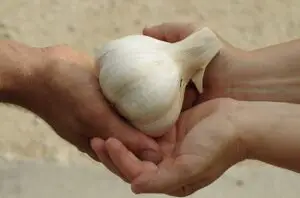
Elephant Garlic is a vegetable that starts with E, and is in the onion family and is usually confused with regular garlic.
But the reason it’s called Elephant Garlic is it is much bigger than regular garlic. Also, Elephant Garlic does not have as strong of a flavor as regular garlic and is easier for most to eat raw.
It has a sweeter flavor that is more closely related to the onion, which is why it can be eaten raw.
Elephant Garlic contains allicin, which makes regular garlic so health beneficial. It also contains some sulfur compounds which are found in onions and leeks but are not found in regular garlic. Because of this, Elephant Garlic is actually more closely related to onions than to garlic.
Elephant Garlic Benefits
- It may have anticancer properties Study
- Contains vitamins A, B, C, and E
- Contains allicin which has antioxidant and antibacterial properties
- Contains flavonoids
- Has minerals
- Effective against colds, flu, Candida yeast and stomach viruses
- Allicin lowers blood pressure
- Also lowers triglycerides and insulin levels
- Protects against colon cancer
Elephant Apple

A much lesser-known fruit beginning with E is the Elephant Apple. The Elephant Apple is a common name for the Chalta, which grows mostly in Southeast Asia and India. It’s called the Elephant Apple since in the wild it is commonly consumed by elephants, as well as other wildlife.
The collection of the Elephant Apple from the main areas of the forest is not allowed, since it is food for the animals. Its sale commercially is also not allowed in order to prevent the harvesting of the fruit from the animals.
The fruit is large, roundish and a green-yellow color.
How to Eat Elephant Apple
Elephant Apple fruit is commonly used to flavor foods and cuisines. It’s also made into jams, curries, pickled, and put in juices. Some consume them raw.
It has a sour taste like a green apple and a pleasant smell. It’s also said to have a flavor like garlic or onion to it as well. The Elephant Apple is also mixed with spices and coconut to make chutneys.
Benefits of Elephant Apple
- High in vitamin B, C, E and potassium.
- Contains antioxidants
- Anticancer properties
- Antibacterial
- High in phytochemicals and flavonoids
- Mood and memory enhancing
- Detoxifies the body
- Good for the kidneys. Ancient Indian researchers touted it as being a medicine for kidney problems.
- Tannin helps with stomach issues.
- Potassium helps to lower blood pressure.
- Vitamin A helps with eyesight.
Escarole
Escarole is closely related to endive and is from the same family. The taste is slightly less bitter though. (To learn more about the difference between the two, see Endive vs. Escarole)
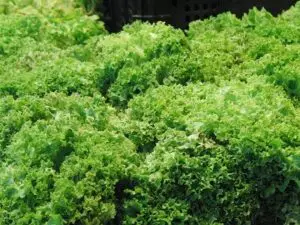
Benefits of Escarole
- High in fiber
- High in vitamin A, C, calcium and iron
How to Eat Escarole
You would eat escarole just like endive. Most commonly it would be put into salads.
Elderberry
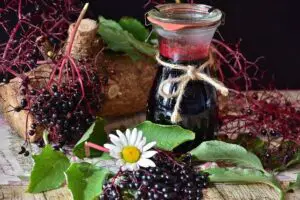
Another on the list of fruits beginning with the letter E, one you may not have heard of, is elderberry. Elderberry is several different variants of the Sambucus tree. It’s a plant flowering plant in the Adoxaceae family.
The berries are very tart and need to be cooked to be eaten. The flowers of the elderberry are also edible and good for health.
Elderberry is a medicinal plant, and one of the most used in the world. In history, it was used by the Egyptians for their skin and to heal burns. Native Americans also used it to treat infections. In modern times it’s used to treat cold and flu symptoms.
Health Benefits of Elderberry
- High in nutrients. 100 grams of berries give 60% RDI of Vitamin C
- High in antioxidants. One study looking at 15 different types of berries and another study looking at different wines, found elderberry to be one of the most effective antioxidants. One study found that one hour after drinking elderberry juice, participants had higher antioxidant levels. Bear in mind that the processing of elderberries into juices or heating may reduce antioxidant levels.
- Reduce inflammation. A study in rats found elderberry reduced inflammation and oxidative tissue damage.
- Help with cold and flu symptoms. Elderberry extract has been shown to reduce the length of influenza and colds and to reduce symptoms.
- May improve heart health. Studies have shown elderberry juice to decrease fat in the blood and reduce cholesterol. Other studies have shown a positive effect on blood sugar levels.
- Have phenolic acids. These are powerful antioxidants.
- Has flavanols. They contain the antioxidant flavanols quercetin, isorhamnetin and kaempferol. The flowers contain up to 10 times more flavanols than the berries.
- High in anthocyanins. This is the antioxidant that gives the elderberries their dark purple color.
- Fights cancer. Test tube studies have shown some elderberries to have cancer-fighting properties.
- May improve symptoms of sinusitis and bronchitis. Elderberries have been shown to prevent bacteria growth.
- Might help with depression. Rats given elderberry extract showed increased performance and mood indicators.
- Improve the immune system. Elderberry polyphenols increased the number of white blood cells in rats.
Ways to Eat Elderberry
You can’t usually find elderberries in supermarkets, since demand is very low. You might be lucky to find some growing in the wild, but be cautious and smart and consult with an expert before consuming anything you find. Some species are toxic before they are ripe. Only pick them after they are dark-colored, plump, and soft. Here are some ways to eat elderberry.
- Elderberry Pie
- Elderberry Jam and Jelly
- Elderberry Syrup
- Elderberry Wine
- The elderberry flowers can be eaten raw or put into teas.
Elderberry Recipes
Here’s a recipe for Homemade Elderberry Syrup. Should you happen to have some elderberries to use.
Elephant Foot Yam
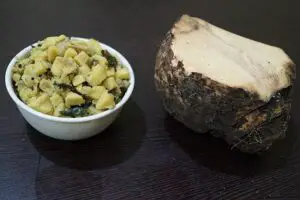
The Elephant Foot Yam probably has the most interesting name of all the vegetables that start with e. The Elephant Foot Yam is grown in Southeast Asia and the Pacific Islands, as well as in Africa in Madagascar.
The Elephant Foot Yam is also called Suran or Ol and is found in Indian dishes.
The Elephant Foot Yam is a tuber or root vegetable and it is commonly mashed or fried and added to curries. It can also be fried to make chips.
Also, the Elephant Foot Yam stems and leaves are sometimes fried and eaten as well. In the Philippines, the Elephant Foot Yam is known as pongapong and the leaves and stems are eaten as well.
Elephant Foot Yams can be packed with nutrition. Let’s look at some of the Elephant Foot Yam benefits below.
Elephant Foot Yam Benefits
- Cheap source of carbohydrates. The Elephant Foot Yam is a staple in many cultures and provides a lot of nutrition and a plant-based food at a cheap cost. The Elephant Foot Yam also contains some protein.
- Contains vitamins and minerals
- Provides magnesium, potassium, zinc, calcium, phosphorous and selenium
- Provides antioxidants
- High in fiber
- Helps with weight loss due to high fiber content
- Helps with digestive issues such as constipation and cramps. Sometimes Elephant Foot Yam is used in laxatives.
- Very sustainable and grows very easily, even in harsh conditions
- Reduces bad cholesterol (LDL) due to phytosterols and is a heart-healthy food
- Raises good cholesterol levels
- Helps with hormones in females. Boosts estrogen production and contains B6 to help with menopause.
- Reduces blood pressure and hypertension
- Helps blood flow by reducing vein blockage
- Anti-coagulant and may help prevent heart attacks and stroke
- Increases red blood cell production
- Improves the immune system
- Reduces inflammation
- Anti-aging
- Detoxifies the body including the liver, stomach and intestines.
- Used in India to treat tumors, arthritis, fatigue and more.
- Helps with memory
- The high fiber content helps to prevent colon cancer
- Good for the skin. The antioxidants help to promote skin health.
- Used in the treatment of hemorrhoids due to helping with constipation.
- Anti-bacterial
- Elephant Foot Yam seeds can be crushed to relieve toothache.
It’s also great that these vegetables in India are also used as a meat substitute. This is great since a Plant-based diet is the healthiest way to eat.
You can find more about the Elephant Foot Yam in these related posts:
Entawak
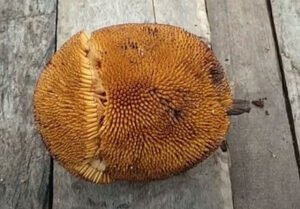
The final fruit that starts with E, the Entawak fruit is also called the mentawa. The Entawak grows in tropical climates such as Indonesia. It is distantly related to the jack fruit.
Entawak is a yellow or brown round fruit, usually about 3-4 inches. The taste of the inside is sweet in flavor and tastes like squash or pumpkin. Also, just like a pumpkin, the seeds can be roasted and eaten.
Entawak Benefits
- Contains vitamins, antioxidants, and fiber
- Entawak seeds are high in riboflavin and thiamin
- It May have anticancer benefits
- Detoxifies the body
How to Eat Entawak
Entawak is usually eaten raw. The seeds can be roasted and then eaten.
Read more about the Entawak, Mentawa, Bintawa or Artocarpus anisophyllus fruit.
Enset (Ensete) or Ethiopian Banana

The enset, or ensete ventricosum, is not well known in the Western world. You may never even encounter the enset, unless you are in Ethiopia or another African country. The enset might even make the list of world superfoods in the coming years.
It is a crop that is a staple in the Ethiopian diet but is only found domesticated there. It does grow in other African countries, but it grows wild, only having been domesticated at this time in Ethiopia.
False Banana
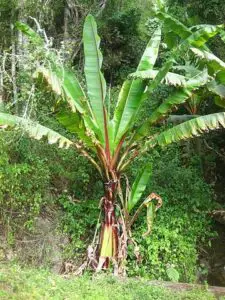
It is sometimes called the ‘False Banana‘ since it resembles the banana tree very closely. Unlike the banana though, the fruit is not edible.
The enset is a root vegetable, and the fruit of the tree is actually not edible, since it is full of seeds. It is the starchy root part that is eaten as enset. It is known for being extremely durable against drought, and it also yields more than other cereal crops, acre for acre.
Enset is being called the “Tree against hunger” and DNA is being developed to make it a more domesticated crop. One reason enset is called this is that it can be harvested year-round. The enset is usually made into a porridge or bread to be eaten.
Enset Benefits
- High in potassium, calcium and iron
- High yield of the crop
- Durable against drought
Emu Berry
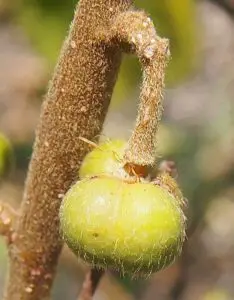
Much like the Emu Apple, the Emu Berry is also native to Australia. The Emu Berry is a tiny two-lobed berry with a sweet taste.
It grows on a shrub that is between 1-3 meters tall.
How to Eat Emu Berry
The emu berry has a nice taste. It can be boiled to make drinks. The entire plant is boiled by the natives and used for medicinal purposes.
Benefits of Emu Berry
Emu Berry is used in many ways by the natives dating back many years.
- High in Calcium
- High in Iron
- High in Fiber
- Contains some Vitamin C
- Eating the entire plant is known to help with diarrhea, scabies, fatigue, headache and boils.
- The entire plant is boiled in order to help with colds
- Antiulcer properties
- Helps with pain
Emu Apple
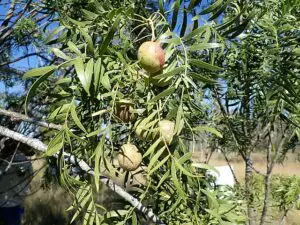
Another of the fruits that start with E, is the Emu Apple. The Emu Apple fruit is found in Australia in the Outback woodlands. The tree that bears the fruit is a small to medium-sized tree that can grow 3-10 meters high. The tree produces a small and edible ball-shaped fruit of only about 2-4 cm, about the size of a golf ball or nectarine, with a large seed in the center.
The color of the Emu Apple is a reddish-purple with lighter specks.
How to Eat Emu Apple
Emu Apple is usually eaten raw and can be also cooked. The taste is like that of a sour plum. The best thing to do is to allow it to ripen for a couple of days after it falls from the tree. Some people even recommend burying it for a couple of days.
Benefits of Emu Apple
- High in Vitamin C
Evergreen Huckleberry
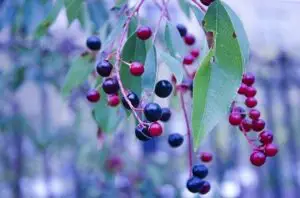
The next on the list of fruits that start with E is the Evergreen Huckleberry. The Evergreen Huckleberry is s plant with berries and leaves that can be eaten. It looks very similar to the previous elderberry fruit.
They are found in the Northwest United States and were historically consumed by Native American tribes. The berries are a deep blue or purple color. Evergreen Huckleberries are very good and people would often travel great distances for them.
The Evergreen Huckleberry fruit is usually eaten by itself, is made into jams, or cooked with.
Evergreen Huckleberry Benefits
- Both the Evergreen Huckleberry fruit and leaves are high in Vitamin A, B and C
- The leaves lower blood sugar levels. Huckleberry leaf tea may be good for diabetes as it decreases blood sugar levels.
- The leaves contain quinic acid which helps inhibit uric acid formation and good for gout
- Evergreen Huckleberry tea helps with glycosuria and hyperglycemia
- High in antioxidants
- Help with blood circulation
- Have antiseptic and astringent properties that might help urinary problems
How to Eat Evergreen Huckleberry
The Evergreen Huckleberry berries are sweet and tasty and can be eaten by themselves. They can also be used in making jams, preserves, or pies. The leaves are used in making tea.
Evergreen Huckleberry Recipes
You can find some Huckleberry Pie recipes below
Here are some other Evergreen Huckleberry recipes:
Earthnut Pea
Next on the list of vegetables that start with E is one that is very uncommon. The Earthnut Pea (Lathyrus tuberosus), also called the Tuberous Pea, was more popular as a tuber in ancient times.
It is not common but is still found today in Middle Europe. Also, it may be consumed still in Turkey as well. They are said to taste fantastic when boiled.

Earthnut Pea Benefits
- High in Vitamin C
- High in Calcium
Egg Fruit
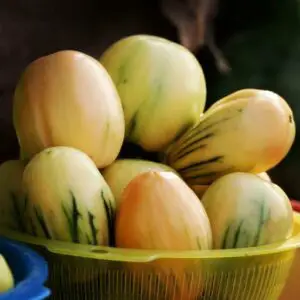
The Egg Fruit is the common term used for Canistels, which are native to Southern Mexico. Egg fruits are fruits found in subtropical or tropical climates. They are an orange-yellow color and have a bulb-like shape.
They are called Egg Fruit because their outside is yellow colored like egg yolk and their inside texture resembles that of a hard-boiled egg yolk. They are grown mainly in Central America, Southern Mexico and the Caribbean.
Benefits of Egg Fruit
- Helps vision and the immune system. Egg fruits are high in Vitamin A from the pigment in the flesh.
- Helps bone strength. They are high in calcium and phosphorous.
- Contains iron
How to Eat Egg Fruit
Egg fruits can be eaten by themselves as a fruit, or with salt or lemon juice added. They can be put on salads or spread on toast. The Egg Fruit can be used in dishes as a sugar substitute, due to its sweet nature. It can also be blended with almond milk or oat milk to make a plant-based smoothie.
Fruits and Vegetables Lists
Fruits and Vegetables A-Z
- Fruits and Vegetables that Start with A
- Fruits and Vegetables that Start with B
- Fruits and Vegetables that Start with C
- Fruits and Vegetables that Start with D
- Fruits and Vegetables That Start With E
- Fruits and Vegetables that Start with F
- Fruits and Vegetables that Start with G
- Fruits and Vegetables that Start with I
- Fruits and Vegetables that Start with M
- Fruits and Vegetables that Start with R
- Fruits and Vegetables that Start with X
- Fruits and Vegetables that Start with Y
- Fruits and Vegetables that Start with Z
- Fruits and Vegetables Lists A-Z
Fruits A-Z
- List of Fruits from A-Z (in Alphabetical Order)
- Fruits that Start with A
- Fruits That Start with B
- Fruits that Start with C
- Fruits that Start with D
- Fruits that Start With E
- Fruits that Start with F
- Fruits that Start with G
- Fruits that Start with I
- Fruits that Start with M
- Fruits that Start with R
- Fruits that Start with S
- Fruits that Start with W
- Fruits that Start with X
- Fruits that Start with Y
- Fruits that Start with Z
- 100 Fruit Names (Most Popular Fruits in the World)
- Top 50 Fruits Names List
- Top 20 Fruit Names
- Fruits Lists A-Z
- List of Berries A-Z
- Berries Lists A-Z
Vegetables A-Z
- Vegetables List A-Z in Alphabetical Order
- Vegetables that Start with A
- Vegetables that Start with B
- Vegetables that Start with C
- Vegetables that Start with D
- Vegetables that Start with E
- Vegetables that Start with F
- Vegetables that Start with G
- Vegetables that Start with I
- Vegetables that Start with M
- Vegetables that Start with R
- Vegetables that Start with X
- Vegetables that Start with Y
- Vegetables that Start with Z
- Vegetables Lists A-Z
- 100 Vegetable Names (Most Common in the World)
Final Thoughts Fruits and Vegetables that Start with E
This has been a long list of fruits and vegetables that start with E! Hopefully, you were able to find some new and exciting ones to incorporate into your daily eating routine.
Are there any other fruits and vegetables that begin with E that were left out? What are your favorite fruits and vegetables starting with E? Comment below!
Video resources:
Lance has been passionate about the plant-based diet and we have been following a whole food plant-based diet for over 5 years. We focus on health, natural healing, weight management, animal rights, and the health of the planet and environment by focusing on whole plant-based foods and sustainable practices.
Learn more at the About Me page and follow on social media at the links below.

